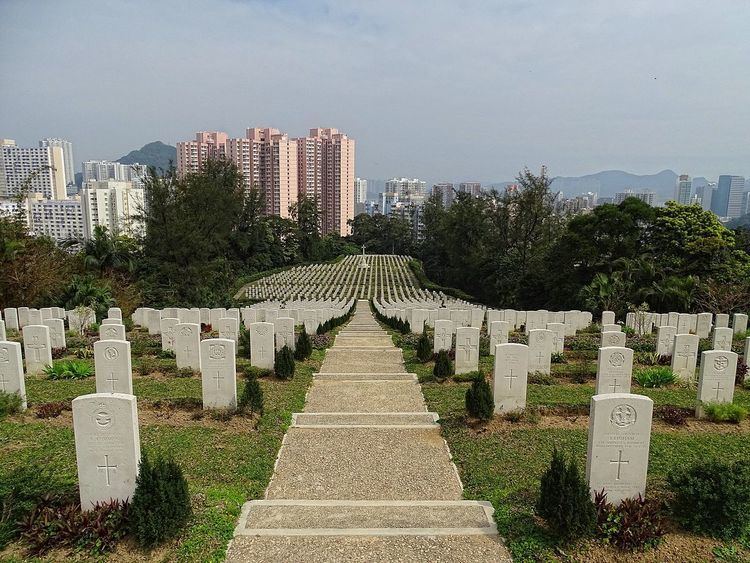Unveiled 1946 Total commemorated 2072 Total burials 1,528 | Designed by Colin St Clair Oakes Address Tai Tam Gap, Hong Kong Unknown burials 444 | |
 | ||
Hours Open today · 8AM–5PMTuesday8AM–5PMWednesday8AM–5PMThursday8AM–5PMFriday8AM–5PMSaturday8AM–5PMSunday8AM–5PMMonday8AM–5PMSuggest an edit Similar Stanley Military Cemetery, Hong Kong Cemetery, Tseung Kwan O Chinese, Cape Collinson Chinese, Parsee Cemetery | ||
Prime minister trudeau visits sai wan war cemetery
Sai Wan War Cemetery (Chinese: 西灣國殤紀念墳場) is a military cemetery located in Chai Wan, Hong Kong. The cemetery contains the graves of the dead of the Second World War, mostly soldiers from the Commonwealth and Allied Forces who fell during the Battle of Hong Kong. The Sai Wan Bay Memorial includes the names of 228 Canadians who died in the defence of Hong Kong.
Contents
- Prime minister trudeau visits sai wan war cemetery
- Background
- Location
- The cemetery
- Notable graves
- References
Background
On 8 December 1941 – less than eight hours after the attack on Pearl Harbor – Japanese forces launched an invasion into Hong Kong, then a British Crown colony. The invasion started a lesser-known chapter of World War II when Commonwealth forces – mainly British and Canadian – began the futile defence of the territory.
The Japanese forces easily crossed Sham Chun River, and entered into the territory through the Mainland in the north. They successively forded two lines of defence and eventually crossed Victoria Harbour. Intense battles were fought on Hong Kong Island until the British surrendered the territory at the end of the month on Christmas Day. The surrender marked the beginning of the Japanese occupation of the territory and would last until the Japanese unconditionally surrendered three years later.
Casualties were heavy among defending forces during the battle, but many more succumbed to disease, drowning, maltreatment, or execution during their long captivity in Hong Kong and Japan, and transportation between the two.
The majority of the fallen Allied soldiers from the campaign, including British, Canadian and Indian soldiers were eventually interred at the Sai Wan Military Cemetery. A total of 1,528 soldiers, mainly from the Commonwealth, are buried here. Most of the remaining burials are located at the Stanley Military Cemetery.
Location
The cemetery is located on the northeastern corner of Hong Kong Island. The site of the cemetery is situated midway up on the north side of Mount Collinson on Cape Collinson Road. The site gradually slopes down towards the sea which used to provide a magnificent view of the harbour narrow at Lei Yue Mun. Incidentally Lei Yue Mun was where the Japanese had crossed the harbour on the evening of 18 December and landed on Hong Kong Island. That same night 20 gunners at the Sai Wan Battery were massacred.
Today, the view of the harbour is obstructed by residential high rises in Chai Wan, and only on a clear day Kowloon would be visible across the harbour. The area also has a few other cemeteries. The Holy Cross Roman Catholic Cemetery; Hong Kong Military Cemetery; and the Cape Collinsion Muslim and Buddhist Cemeteries are within walking distance from one another. Further east just a few hundred meters away on the side of Pottinger Peak is the larger Cape Collinson Chinese Permanent Cemetery.
The cemetery
The cemetery was built in 1946. It is now one of the many maintained by the Commonwealth War Graves Commission since the land has been leased since 1953. A memorial hall marks the entrance into the cemetery, which bears the names of more than 2,000 Commonwealth servicemen who died in the Battle of Hong Kong or subsequently in captivity and those who have no known grave. Additional panels form the cremation memorial bearing the names of 144 casualties whose remains were cremated in accordance with their faith. Also, the Sai Wan (China) Memorial commemorating 72 casualties of both World Wars whose graves in mainland China could not be maintained can be found at the memorial hall. Twenty local soldiers and eight civilians are also buried here. A plaque displaying the battle and army advances gives visitors the insight into the extent of the campaign.
The graves are marked with white upright granite headstones depicting the appropriate regiment or service's insignia. The cemetery is enclosed within a wall of flowering shrubs and bushes. An Altar of Remembrance, bearing the words from Sirach: "Their name liveth for evermore" marks the top of the flight of stone steps leading down a center aisle towards the Cross of Sacrifice. Both the cemetery and memorial were designed by Colin St. Clair Oakes.
Other than those died in defence of Hong Kong, the remains of POWs who died in Taiwan were brought to Sai Wan for burial as well. There are now 1,528 casualties of World War II buried or commemorated at Sai Wan War Cemetery, 444 of the burials are unidentified. The unidentified were marked with the words: Known Unto God. In addition, there are special memorials to 16 World War II casualties buried in a Kowloon Muslim cemetery whose graves were lost. There are also 77 war graves of other nationalities from this period, the majority of them Dutch. The cemetery also contains special memorials to 12 World War I casualties buried in another Kowloon Muslim cemetery whose graves have since been lost.
Notable graves
About 280 servicemen were from Canada, including Brigadier John K. Lawson. Lawson was the highest-ranking officer to be killed in action during the defence of Hong Kong, his remains were originally buried by the Japanese at Wong Nai Chung Gap during the occupation but were reburied at the cemetery. Another of two Major General Lancelot Ernest Dennys and Merton Beckwith-Smith were also buried in this cemetery.
Company Sergeant-Major John Robert Osborn, recipient of the only Victoria Cross awarded for the defence of Hong Kong, has no grave at this cemetery, but his name is engraved on the memorial hall.
